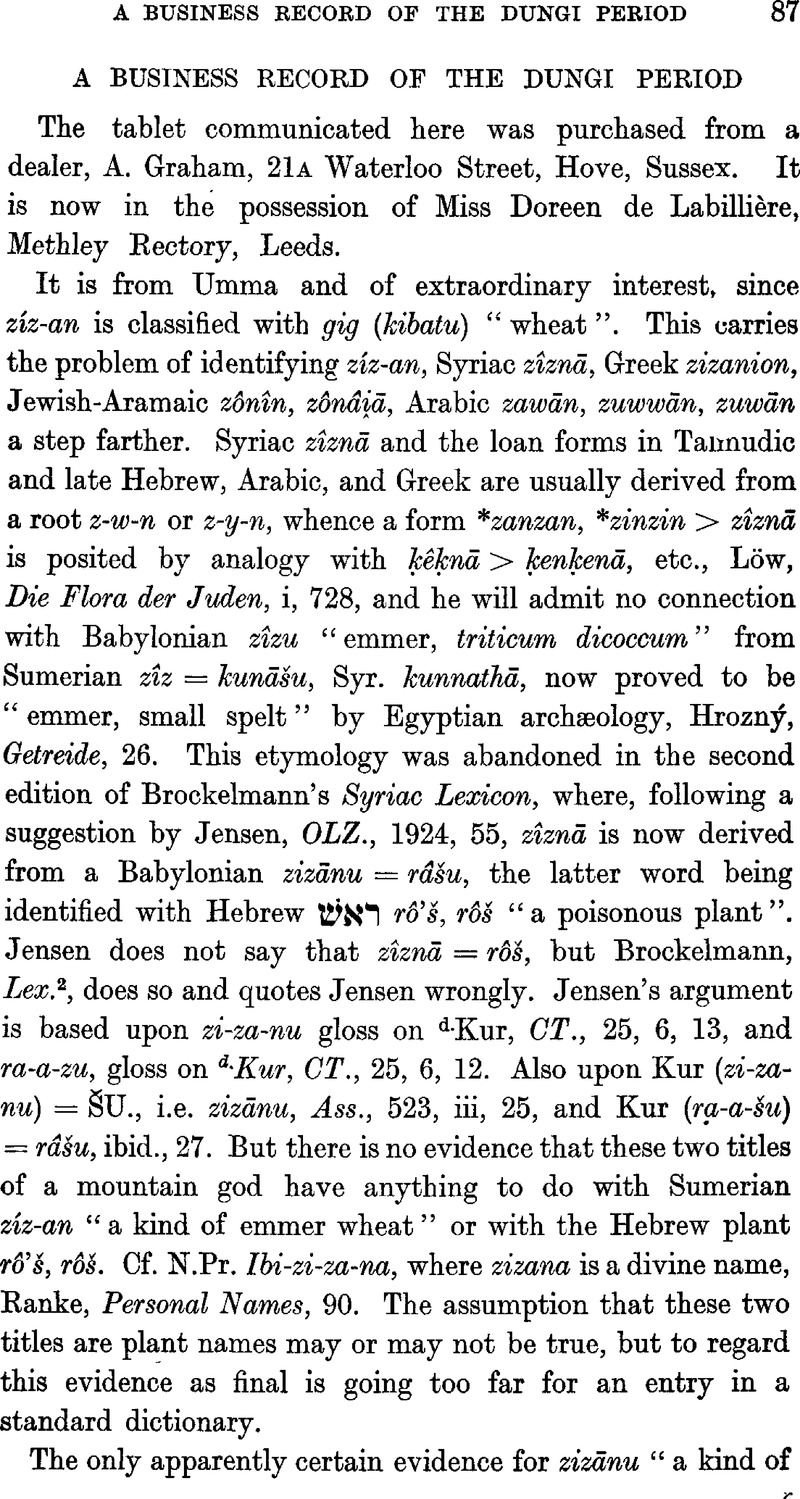No CrossRef data available.
Article contents
A Business Record of the Dungi Period
Published online by Cambridge University Press: 15 March 2011
Abstract

- Type
- Miscellaneous Communications
- Information
- Copyright
- Copyright © The Royal Asiatic Society 1936
References
page 88 note 1 Danby, , The Mischna, 28Google Scholar, translates “tares” after the usual tradition, and comments “bearded darnel”.
page 88 note 2 Löw, , Flora der Juden, i, 729Google Scholar, cites also an Arabic form zîzân.
page 89 note 1 i.e. charged to the account of Ur-shara. šag-dub = ṣipû, letter in an envelope, CT. 12, 33, K. 2034, Rev. ii, 2. The witnesses to a šag-dub-ba-ka “case tablet”, Genouillac, , Inventaire, ii, 3532, 9Google Scholar. gab-ri šag-dub-ba “duplicate of a ease tablet”, 4710, Rev. 6. A letter is called šag-dub-ba, YOS. iv, 131. šag-dub-áš-áš, case tablets in pairs, duplicates, Hussey, , Harvard, i, 2Google Scholar, Obv. i, 3; 3, i, 4; 15, Rev. viii, 3. dub = ṣipû, CT. 11, 29 A 40; 12, 14 A 4, after lamû “to enclose”. šag-dub “the interior of a tablet”. Two forms of this verb, ṣapû, ṣapû “to cover, enclose, wrap” exist, ṣîpu, ṣi'pu, letter, Arabic ṣaḥifatun, is derived from ṣapû. ṣâpû “to colour, overlay with paint” is the same verb. A secondary dissimilated form is ṣabû “to wrap”, Maḳlû, vii, 58; Weissbach, , BA., iv, 161–2Google Scholar. dup-pi ṣa-pí-ti “a case tablet”, Ebeling, , KAJI. 122, 4–5Google Scholar. Deimel, , Lexikon, p. 748, 100Google Scholar, confused the noun ṣpû with the verb ṣapû.
page 89 note 2 Sig = ![]() . The same name is written with Sig =
. The same name is written with Sig = ![]() , Legrain, , Ur, 24, 3Google Scholar; 25, 6. Lù-bal-Síg, Schneidner, , Drehem, p. 30Google Scholar.
, Legrain, , Ur, 24, 3Google Scholar; 25, 6. Lù-bal-Síg, Schneidner, , Drehem, p. 30Google Scholar.
page 89 note 3 mu-ki-2-šú. This expression mu-ki-2-šú is certainly equivalent to mu-ki-4, 5, 6, up to 31, in the dates of Rim-Sin, “fourth, fifth, sixth, etc., year” (after he captured Isin), Thureau-Dangin, , Chronologie des Dynasties de Sumer et d'Accad, 9–10Google Scholar. It is also equivalent to mu-uš-sa ki-18 Isinna, (ki) bandib “Eighteenth year after he captured Isin”, and to mu-uš-sa 5-kam “Fifth year after”, SAK. 237–8, and to mu-4-kam-ma “Fourth year (after)”, Chronologie, 6, 62, etc. A similar formula is the double date mu-8 ki 10 Isinna(ki) bandib “The year eight (of Hammurabi ?) is (year) 10 of (i.e. after) the capture of Isin”, RA. 27, 80. This same ki in the double date cited RA. 27, 81, mu-ki-18-kam. mu-ki-4-kam, therefore, has the same sense as mu-4-kam “fourth year”, and mu-uš-sa ki-4 “year after, fourth”; hence mu-ki-4-šú = mu-ki-4-kam. ki-šú must be a compound preposition and when used with numbers it has the force of an ordinal, precisely as á-m < 4-kam; a form, ki-4-kam is, therefore, a hybrid. ki-2-šú, de la Fuÿe, Allotte, Documents Pre-Sargoniques, 220, i, 6Google Scholar; ii, 5, means “second time”, i.e. 2-ám. Apparently this form of the ordinal cannot be used for “first”, ki-l-šú. ki-šú, literally “at the place of” is rendered by ana ṣêri in ki-me-šú = ana ṣêri-ni “upon us”, PBS. v, 152, viii, 23. But ki in this expression for the ordinal seems to mean “time”, ki-2-šú “for the second time”, zweimal, and then used for “second”. But in line 21 mu-3 “third year”, and line 27, mu-4-kam, the ordinary ordinal.
page 90 note 1 Thureau-Dangin, RA. 3, 139, suggested siltu “sifted meal”.
page 90 note 2 This same method of numbering years by numbers at Umma occurs also on four early tablets from Umma, RA. 8, 158. See RA. 32, 138.
page 90 note 3 This seal was probably impressed on the envelope now lost. Ganam is an uncertain identification. Cf. N.pra. Lù-ba, Geme-ba, Ḫa-ba, Ḫu-ba.
page 90 note 4 The scribe wrote 14 and then erased the figure 10.


